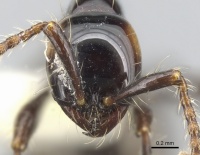Aenictus brevinodus
| Aenictus brevinodus | |
|---|---|

| |
| Scientific classification | |
| Kingdom: | Animalia |
| Phylum: | Arthropoda |
| Class: | Insecta |
| Order: | Hymenoptera |
| Family: | Formicidae |
| Subfamily: | Dorylinae |
| Genus: | Aenictus |
| Species: | A. brevinodus |
| Binomial name | |
| Aenictus brevinodus Jaitrong & Yamane, 2011 | |
This species occurs in lowland and highland forests. Workers of the type series were found raiding on low vegetation along a road.
Identification
A member of the laeviceps species group. Jaitrong and Yamane (2011) - A. brevinodus is quite similar to Aenictus hodgsoni. However, it has fewer standing hairs on the mesosomal dorsum (less than 10 hairs in A. brevinodus; more than 20 in A. hodgsoni); the petiolar node is clearly shorter than high (almost as long as high or slightly longer than high in A. hodgsoni); and the legs are entirely smooth and shiny (femora extensively superficially reticulate and shiny, and tibiae very finely reticulate in the latter).
Keys including this Species
Distribution
Distribution based on Regional Taxon Lists
Indo-Australian Region: Indonesia (type locality), Sulawesi.
Distribution based on AntMaps
Distribution based on AntWeb specimens
Check data from AntWeb
Countries Occupied
| Number of countries occupied by this species based on AntWiki Regional Taxon Lists. In general, fewer countries occupied indicates a narrower range, while more countries indicates a more widespread species. |

|
Estimated Abundance
| Relative abundance based on number of AntMaps records per species (this species within the purple bar). Fewer records (to the left) indicates a less abundant/encountered species while more records (to the right) indicates more abundant/encountered species. |

|
Biology
Castes
Known only from the worker caste.
Nomenclature
The following information is derived from Barry Bolton's Online Catalogue of the Ants of the World.
- brevinodus. Aenictus brevinodus Jaitrong & Yamane, 2011: 33, figs. 46-48 (w.) INDONESIA (Sulawesi).
- Type-material: holotype worker, 45 paratype workers.
- Type-locality: holotype Indonesia: S Sulawesi, Laiya, Labbang, 24.i.2010, CE10-SKY-15 (Sk. Yamane); paratypes with same data.
- Type-depositories: MZBJ (holotype); BMNH, FFKT, SKYC, TNHM (paratypes).
- Distribution: Indonesia (Sulawesi).
Unless otherwise noted the text for the remainder of this section is reported from the publication that includes the original description.
Description
Worker
Measurements. Holotype and paratypes (n = 7): TL 3.65–3.75 mm; HL 0.78–0.83 mm; HW 0.70–0.73 mm; SL 0.65–0.70 mm; ML 1.15–1.20 mm; PL 0.23–0.25 mm; CI 88–91; SI 93–97.
holotype and paratypes - Head in full-face view rather oval, slightly longer than broad, with sides distinctly convex and posterior margin almost straight or weakly convex; occipital carina weak but complete. Antennal scape relatively short, in full-face view not reaching posterolateral corner of head; antennal segments II–X each longer than broad; II almost as long as each of III–V; terminal segment (X) almost as long as VII+VIII+IX. Frontal carina short, slightly extending beyond posterior margin of torulus; parafrontal ridge absent. Anterior margin of clypeus slightly convex, bearing 8 denticles. Masticatory margin of mandible with a large apical tooth followed by a medium-sized subapical tooth, 3–4 denticles, a medium-sized subbasal tooth and a smaller basal tooth (the latter two widely separated from each other); basal margin lacking denticles. Promesonotum in profile strongly convex and forming a dome, mesonotum sloping to metanotal groove; propodeum distinctly lower than promesonotum, with its dorsal outline almost straight; propodeal junction rather sharply to roundly angulate; declivity of propodeum seen in profile vertical, almost straight or feebly concave, irregularly sculptured, without a distinct rim separating the declivity from other parts. Petiole subsessile and rather short, its node slightly shorter than high; subpetiolar process hook-like, variable in size, with apex directed downward and backward; postpetiole distinctly larger than petiole.
Entire head including antennal scape smooth and shiny. Mandible very finely striate except along masticatory margin and near base. Pronotum entirely smooth and shiny except for anteriormost portion punctate; dorsa of both mesothorax and propodeum extensively smooth; small posterior portions of mesothorax and propodeum, and lower part of metapleuron irregularly punctate or rugulose. Petiole and postpetiole entirely smooth and shiny. Legs entirely smooth and shiny.
Vertex with a pair of long standing hairs and very sparse short hairs. Mesosoma dorsally with relatively sparse standing hairs mixed with very sparse short hairs over the surface; longest pronotal hair 0.20–0.23 mm long. Entire body dark reddish-brown. Typhlatta spot located anterior to occipital corner.
Type Material
Holotype worker from Indonesia, S. Sulawasi, Laiya, Labbang, 24 I 2010, Sk. Yamane leg., CE10-SKY-15 (Bogor Zoological Museum). Fourty-five paratype workers, same data as holotype (Ant Museum, The Natural History Museum, SKY Collection, Natural History Museum of the National Science Museum).
Etymology
The specific name means the short petiole.
References
- Jaitrong, W. & Yamane, S. 2011. Synopsis of Aenictus species groups and revision of the A. currax and A. laeviceps groups in the eastern Oriental, Indo-Australian, and Australasian regions (Hymenoptera: Formicidae: Aenictinae). Zootaxa, 3128, 1–46.
- Liu, C., Fischer, G., Hita Garcia, F., Yamane, S., Liu, Q., Peng, Y.Q., Economo, E.P., Guénard, B., Pierce, N.E. 2020. Ants of the Hengduan Mountains: a new altitudinal survey and updated checklist for Yunnan Province highlight an understudied insect biodiversity hotspot. ZooKeys 978, 1–171 (doi:10.3897/zookeys.978.55767).
References based on Global Ant Biodiversity Informatics
- Borowiec M. L. 2016. Generic revision of the ant subfamily Dorylinae (Hymenoptera, Formicidae). ZooKeys 608: 1–280.
- Jaitrong W.; Yamane, S. 2011. Synopsis of Aenictus species groups and revision of the A. currax and A. laeviceps groups in the eastern Oriental, Indo-Australian, and Australasian regions (Hymenoptera: Formicidae: Aenictinae). Zootaxa 3128:1-46.


